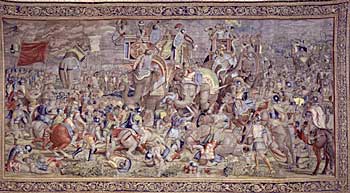Hannibal: Ancient Rome's Greatest Enemy
The Battle of Zama
 The final battle of Hannibal's career took place at Zama in 202 B.C. Roman and Carthaginian armies drew up before each other. This time, however, the military genius that was Hannibal's legacy deserted him. Scipio seemed to have all the answers that day, including that his armies had camped next to a natural spring, whereas Hannibal, who arrived later, had to send miles away for fresh water. It was an unnaturally hot day.
The final battle of Hannibal's career took place at Zama in 202 B.C. Roman and Carthaginian armies drew up before each other. This time, however, the military genius that was Hannibal's legacy deserted him. Scipio seemed to have all the answers that day, including that his armies had camped next to a natural spring, whereas Hannibal, who arrived later, had to send miles away for fresh water. It was an unnaturally hot day.
The first was the shrewd decision to let Hannibal's newly acquired force of war elephants rumble right through the Roman lines. When the elephants charged, the Romans simply opened up lanes of empty space in between their columns, and the elephants tramped straight through, inflicting hardly a blow on the Romans, who then attacked the elephants from behind. A second charge of elephants found a different enemy, one that played the trumpet. Roman trumpeters blared notes on their horns, which confused the elephants enough that they turned right around and charged the Carthaginian army.
The front lines of this Carthaginian army were made up of newer recruits and soldiers from other lands, including Gaul, who suffered from a lack of motivation for fighting to save Carthage when all they got out of it was money and pride. (At least in Italy, they got Roman spoils after a victory.) As the Romans advanced on the heels of the elephants who had turned around, this first line of Gauls and new recruits gave way, with the result being that the second line of defense convinced the retreaters to turn around and fight anew, under pain of death. Seeing such chaos must have warmed Scipio's heart. It wasn't long until the Romans had broken through the first two lines and were face to face with the pride of Hannibal's army, the "Old Guard," heroes of many battles.
At this point in the battle, things still looked relatively even, at least in Hannibal's eyes. One can imagine that Scipio, if he hadn't had one more card up his sleeve, might have worried about the outcome that day. But he didn't worry because he did have one more card to play. It was a devastating card, too. It was the horsemen of Numidia, the same ones that had served Hannibal so well in his devastating victories over Rome in Italy but who had been released from his service and allowed to return home. Scipio had met their price and so now had their services in battle. It was these Numidian horsemen—cavalry who had the advantage of surprise and rest—that turned the tide against Hannibal. They swept back into the fray, after first having driven off the remnants of the first two Carthaginian lines, and gave the victory to Rome.